2010 Alfa Romeo Brera/Spider boot
[x] Cancel search: bootPage 94 of 271

92
SAFETY
DEVICES
WARNING
LIGHTS AND
MESSAGES
IN AN
EMERGENCY
CAR
MAINTENANCE
TECHNICAL
SPECIFICATIONS
INDEX
DASHBOARD
AND
CONTROLS
CORRECT USE
OF THE CAR
BOOT CLOSING
Lower the boot pressing the lock until
hearing the locking click.
IMPORTANT Before closing the boot,
check whether you have with you the
ignition key since the tailgate will be
locked automatically.
The addition of objects
(speakers, spoilers, etc.)
on the rear shelf or boot
lid, except those envisaged by
the manufacturer, may prevent
the gas filled struts at the sides
of the boot from working prop-
erly.
When using the boot,
make sure the loads do
not exceed the permitted
weight (see “Technical specifi-
cations” chapter). Also make
sure the items in the boot are
arranged properly to prevent
them being thrown forwards
and injuring passengers should
you brake sharply.
WARNING
Never travel with ob-
jects on the rear shelf
to prevent them being thrown
forwards and injuring passen-
gers in case of accident or
sharp braking.
WARNING
EXTENDING THE BOOT
The double rear seat enables to extend
the boot totally or partially by splitting
one of the two seat section, thus ob-
taining different loading spaces accord-
ing to the number of rear passengers.
When driving at night
with heavy loads in the
boot, check and adjust, if re-
quired, the low beams height
(see paragraph “Headlights”
in this section).
WARNING
Page 96 of 271

94
SAFETY
DEVICES
WARNING
LIGHTS AND
MESSAGES
IN AN
EMERGENCY
CAR
MAINTENANCE
TECHNICAL
SPECIFICATIONS
INDEX
DASHBOARD
AND
CONTROLS
CORRECT USE
OF THE CAR
Partial extension
Proceed as follows:
❒move seat belt aside; check that the
seat belt is not twisted;
❒lower completely the rear seat head
restraint;
❒raise backrest retaining lever A-
fig. 76and tilt the backrest for-
ward (when raising lever Athe “red
band”Bwill appear).
Make sure the backrest
is properly secured at
both sides (“red bands” B-fig.
76 not visible) to prevent it
moves forward in the event of
sharp braking causing injuries
to passengers.
WARNING
ANCHORING THE LOAD
The boot houses 4 hooks for anchoring
ropes in order to guarantee perfect load
anchoring.
On certain versions, hooks B-fig. 78
can be located on the boot sides.
A0F0131mfig. 78
A heavy load that has
not been secured may
cause serious harm.
WARNING
To return the rear seat
back to its original position
Move aside the seat belts, check that
they are not twisted.
Raise the seat backrests and push them
back until hearing the locking click of
both retainers; the “red band” Baside
the levers Ashall no longer be visible.
The “red band” Bactually indicates that
the backrest is not properly secured.
Page 97 of 271

95
SAFETY
DEVICES
WARNING
LIGHTS AND
MESSAGES
IN AN
EMERGENCY
CAR
MAINTENANCE
TECHNICAL
SPECIFICATIONS
INDEX
DASHBOARD
AND
CONTROLS
CORRECT USE
OF THE CAR
If you want to carry
reserve fuel in a can,
follow law regulations, only
using a certified can, suitably
fastened to the load securing
eyelets. Even in this way the
risk of fire is increased in the
case of an accident.
WARNING
LUGGAGE COVER
(for versions/markets,
where provided)
The luggage cover shall be used to
arrange luggage and/or to carry light
objects.
The cover shall be secured to the two
hooks (one per side) A-fig. 79locat-
ed in the boot.
A0F00010mfig. 79
CARGO BOX
(for versions/markets,
where provided)
It is a special box fig. 80, to be used
to house objects in the boot, that en-
ables to obtain a level loading surface.
A0F0007mfig. 80
Page 100 of 271

98
SAFETY
DEVICES
WARNING
LIGHTS AND
MESSAGES
IN AN
EMERGENCY
CAR
MAINTENANCE
TECHNICAL
SPECIFICATIONS
INDEX
DASHBOARD
AND
CONTROLS
CORRECT USE
OF THE CARHEADLIGHT AIMING DEVICE
It works with the key fitted into the ig-
nition device and dipped beams on.
When the car is loaded, it slopes back-
wards. This means that the headlight
beam rises. In this case, it is necessary
to return it to the correct position.
In this event, to adjust the headlight
slant use control A-fig. 83aset on the
button control panel near the steering
wheel.
If the car is fitted with bixenon head-
lights, headlight aiming is electronic and
therefore control Ais not present.Control has four positions corresponding
to the loads given below:
❒position0- load: driver / driver +
front passenger;
❒position1- load: driver + 3 pas-
sengers / driver + 3 passengers +
load in the boot (65 kg for 2.2 ver-
sion / 50 kg for 3.2 version);
❒position2- load: driver + load in the
boot (290 kg for 2.2 version / 275
kg for 3.2 version);
❒position3- not to be used.
IMPORTANT Check headlight slant
each time the transported load changes.
FRONT FOG LIGHT
ADJUSTMENT
Contact Alfa Romeo Authorized Services
to have the headlights correctly adjust-
ed.
A0F0226mfig. 83a
HEADLIGHT ADJUSTMENT
ABROAD
The dipped beam headlights are adjust-
ed for circulation in the country in which
the car is marketed. In countries with
opposite circulation, to avoid glaring on-
coming vehicles, proceed as follows:
❒remove headlight cover (see para-
graph “Dipped beam headlights” in
section “In an emergency”);
❒move lever A-fig. 84aside.
A0F0050mfig. 84
Page 115 of 271

113
SAFETY
DEVICES
WARNING
LIGHTS AND
MESSAGES
IN AN
EMERGENCY
CAR
MAINTENANCE
TECHNICAL
SPECIFICATIONS
INDEX
DASHBOARD
AND
CONTROLS
CORRECT USE
OF THE CAREMERGENCY OPENING
OF THE FUEL FILLER CAP
In case of failure, the fuel filler cap can
be opened by pulling string set on the
right side of the boot fig. 88.
A0F0130mfig. 88
FUEL FILLER CAP
The fuel tank lid can only be opened
with doors unlocked and engine
switched off.
Opening
Open the flap A-fig. 87by means of
front part (see figure), turn cap Banti-
clockwise and extract it. The cap has a
deviceCretaining it to the flap so it can-
not be lost. When refuelling, attach the
cap to the flap, as illustrated.
Closing
Fit cap Bin its housing and turn it clock-
wise until it clicks once or more, then close
the flap A.
IMPORTANTThe sealing of the tank
may cause light pressurising in the tank.
A little breathing off, while slackening
the cap, is absolutely normal.
Do not put naked
flames or lighted ciga-
rettes near the fuel filler hole
as there is danger of fire.
Do not bend too close to the
hole either so as not to
breathe in harmful vapours.
WARNING
A
B
C
A0F0299mfig. 87
Page 147 of 271

145
SAFETY
DEVICES
WARNING
LIGHTS AND
MESSAGES
IN AN
EMERGENCY
CAR
MAINTENANCE
TECHNICAL
SPECIFICATIONS
INDEX
DASHBOARD
AND
CONTROLS
CORRECT USE
OF THE CAR
Climate control
The air conditioner is an additional load
which greatly affects the engine leading
to higher consumption. When the tem-
perature outside the car permits it, use
the air vents where possible.
Spoilers
The use of aerodynamic optional extras
which are not certified for the specific
use on the vehicle, may reduce the aero-
dynamic penetration of the vehicle and
increase consumption. Unnecessary loads
Do not travel with too much luggage
stowed in the boot. The weight of the
car (especially when driving in town)
and its trim greatly affects consumption
and stability.
Roof rack/ski rack
Remove the roof rack or the ski rack
from the roof as soon as they are no
longer used. These accessories lower air
penetration and adversely affect con-
sumption levels. When needing to car-
ry particularly voluminous objects, prefer-
ably use a trailer.
Electric devices
Use electric devices only for the amount
of time needed. Rear heated window,
additional headlights, windscreen wipers
and heater fan need a considerable
amount of energy therefore, increasing
the requirement of current increases fu-
el consumption (up to +25% in the ur-
ban cycle).CONTAINING
RUNNING COSTS
Here are some suggestions which may
help you to keep the running costs of
your car down and lower the amount of
toxic emissions released into the at-
mosphere.
GENERAL CONSIDERATIONS
Car maintenance
Have checks and adjustments carried out
in accordance with the “Service sched-
ule”.
Tyres
Check the pressure of the tyres routine-
ly at an interval of no more than 4
weeks: if the pressure is too low, con-
sumption levels increase as resistance
to rolling is higher.
Page 153 of 271

151
SAFETY
DEVICES
WARNING
LIGHTS AND
MESSAGES
IN AN
EMERGENCY
CAR
MAINTENANCE
TECHNICAL
SPECIFICATIONS
INDEX
DASHBOARD
AND
CONTROLS
CORRECT USE
OF THE CAR
W W
A A
R R
N N
I I
N N
G G
L L
I I
G G
H H
T T
S S
A A
N N
D D
M M
E E
S S
S S
A A
G G
E E
S S
LOW BRAKE FLUID/HANDBRAKEON .................... 153
BRAKE PAD WEAR ............................................. 153
SEAT BELTS NOT FASTENED................................. 153
AIR BAG FAILURE............................................... 154
PASSANGER’S FRONT AIR BAGS DEACTIVATED ........ 155
ENGINE COOLANT HIGH TEMPERATURE ................. 155
ENGINE OIL HIGH TEMPERATURE.......................... 156
LOW ENGINE OIL PRESSURE/EXHAUST OIL ........... 156
LOW BATTERY CHARGE....................................... 157
INCOMPLETE DOOR LOCKING .............................. 157
BONNET OPEN.................................................. 157
BOOT OPEN..................................................... 157
INJECTION SYSTEM FAILURE/
EOBD SYSTEM FAILURE...................................... 158
CAR PROTECTION SYSTEM FAILURE/
STEERING LOCK INHIBITION ................................ 159
ALARM FAILURE/BREAK-IN ATTEMPT/
ELECTRONIC KEY NOT RECOGNIZED ...................... 159
POSSIBLE PRESENCE OF ICE ON THE ROAD ........... 160
PRE-HEATING GLOW PLUGS/
PRE-HEATING GLOW PLUG FAILURE....................... 160
WATER IN DIESEL FUEL FILTER ............................. 161
INERTIAL FUEL CUT-OFF SWITCHED ON ................ 161
ABS SYSTEM FAILURE ........................................ 162
EBD SYSTEM FAILURE ........................................ 162
VDC SYSTEM ................................................... 162HILL HOLDER FAILURE ....................................... 163
ASR SYSTEM (WHEEL ANTISKID SYSTEM) ............ 163
EXTERNAL LIGHTS FAILURE ................................. 164
BRAKE LIGHTS FAILURE ...................................... 164
REAR FOGLIGHTS.............................................. 164
FRONT FOG LIGHTS........................................... 164
SIDE/TAILLIGHTS/FOLLOW ME HOME.................. 164
DIPPED BEAM HEADLIGHTS ................................. 164
MAIN BEAM HEADLIGHTS ................................... 165
LEFT-HAND DIRECTION INDICATOR ........................ 165
RIGHT-HAND DIRECTION INDICATOR ...................... 165
LIGHT SENSOR FAILURE....................................... 165
RAIN SENSOR FAILURE........................................ 165
PARKING SENSORS FAILURE................................ 165
FUEL RESERVE - LIMITED CRUISING RANGE............ 165
CRUISE CONTROL............................................. 166
DIESEL PARTICULATE FILTER CLOGGED .................. 166
ANTIPINCH SYSTEM FAILURE............................... 167
WINDSCREEN WASHER FLUID LOW LEVEL ............. 167
SPEED LIMIT EXCEEDED...................................... 167
T.P.M.S. SYSTEM FAILURE................................... 167
CHECK TYRE PRESSURE...................................... 167
LOW INFLATION PRESSURE................................. 168
TYRE PRESSURE UNSUITABLE FOR SPEED ............ 168
Page 159 of 271

157
SAFETY
DEVICES
WARNING
LIGHTS AND
MESSAGES
IN AN
EMERGENCY
CAR
MAINTENANCE
TECHNICAL
SPECIFICATIONS
INDEX
DASHBOARD
AND
CONTROLS
CORRECT USE
OF THE CAR
LOW BATTERY
CHARGE (red)
If symbol w+ message are
displayed, contact immediately
Alfa Romeo Authorized Services.
w
INCOMPLETE DOOR
LOCKING (red)
Symbol´+ message on the
display indicate that one of the doors
is not closed.
´
BOOT OPEN
SymbolR(red) + mes
sage on the display indicate
that the boot is open.
BONNET OPEN
(for versions/markets,
where provided)
Symbol
S(red) + message on the
display indicate that the bonnet is open.
S
R
Exhausted engine oil
should be replaced as
soon as possible after the
warning light comes on, never
more than 500 km after the
warning light first comes on.
Failure to change the oil with-
in the first 500 km may result
in severe damage to the en-
gine and will result in forfei-
ture of the warranty.Remem-
ber that when the warning
light flashes, it does not mean
that the level of engine oil is
low, so if the light flashes you
must not top up.
WARNING
Note that engine oil is exhausted faster
under the following circumstances:
– use of the vehicle prevalently for city
driving, requiring more frequent regen-
eration of DPF
– use of the vehicle for short drives, in
which the engine does not have time to
reach its regular operating temperature
– repeated interruption of the regener-
ation process, signalled by the DPF warn-
ing light coming on.